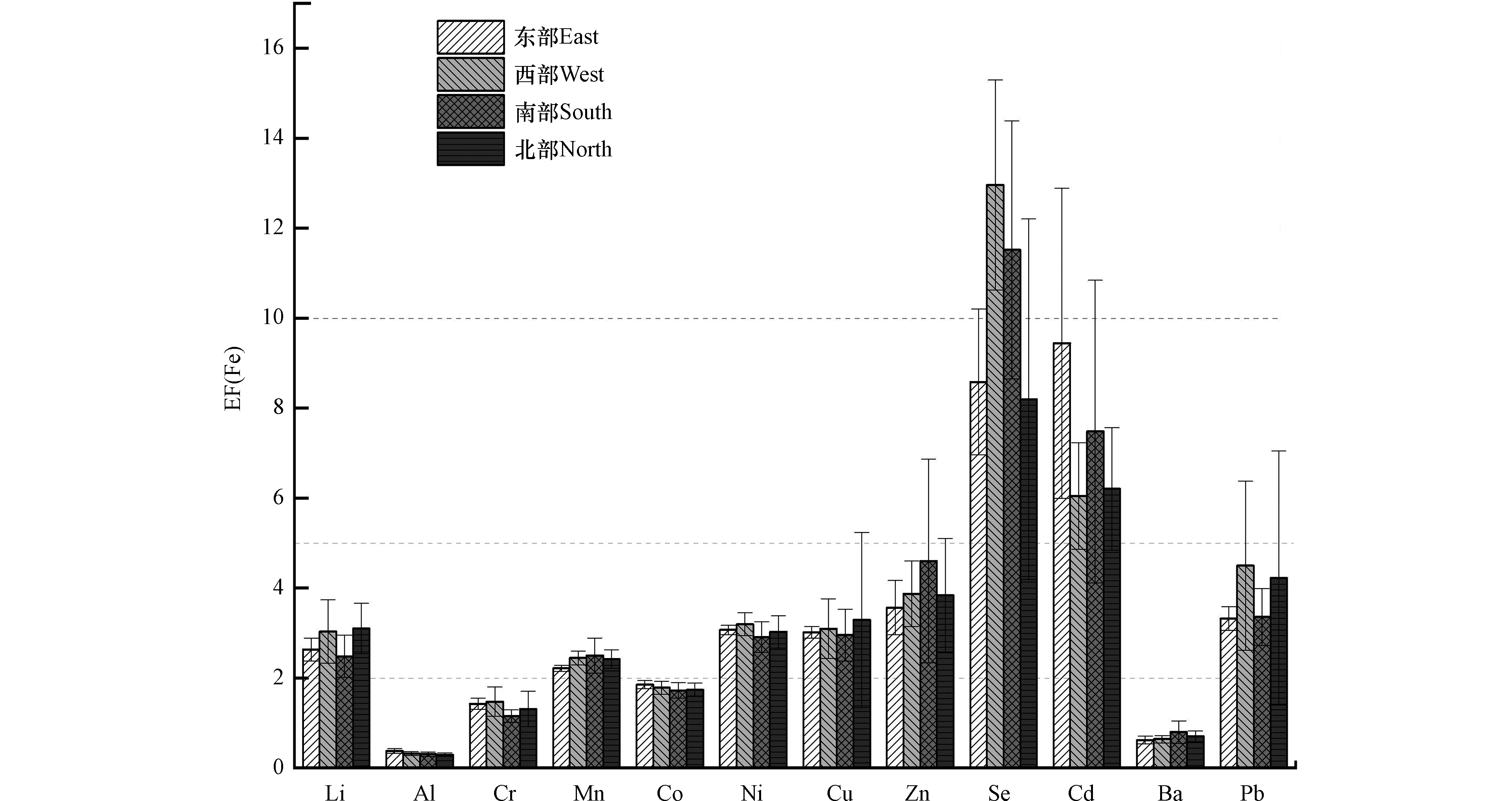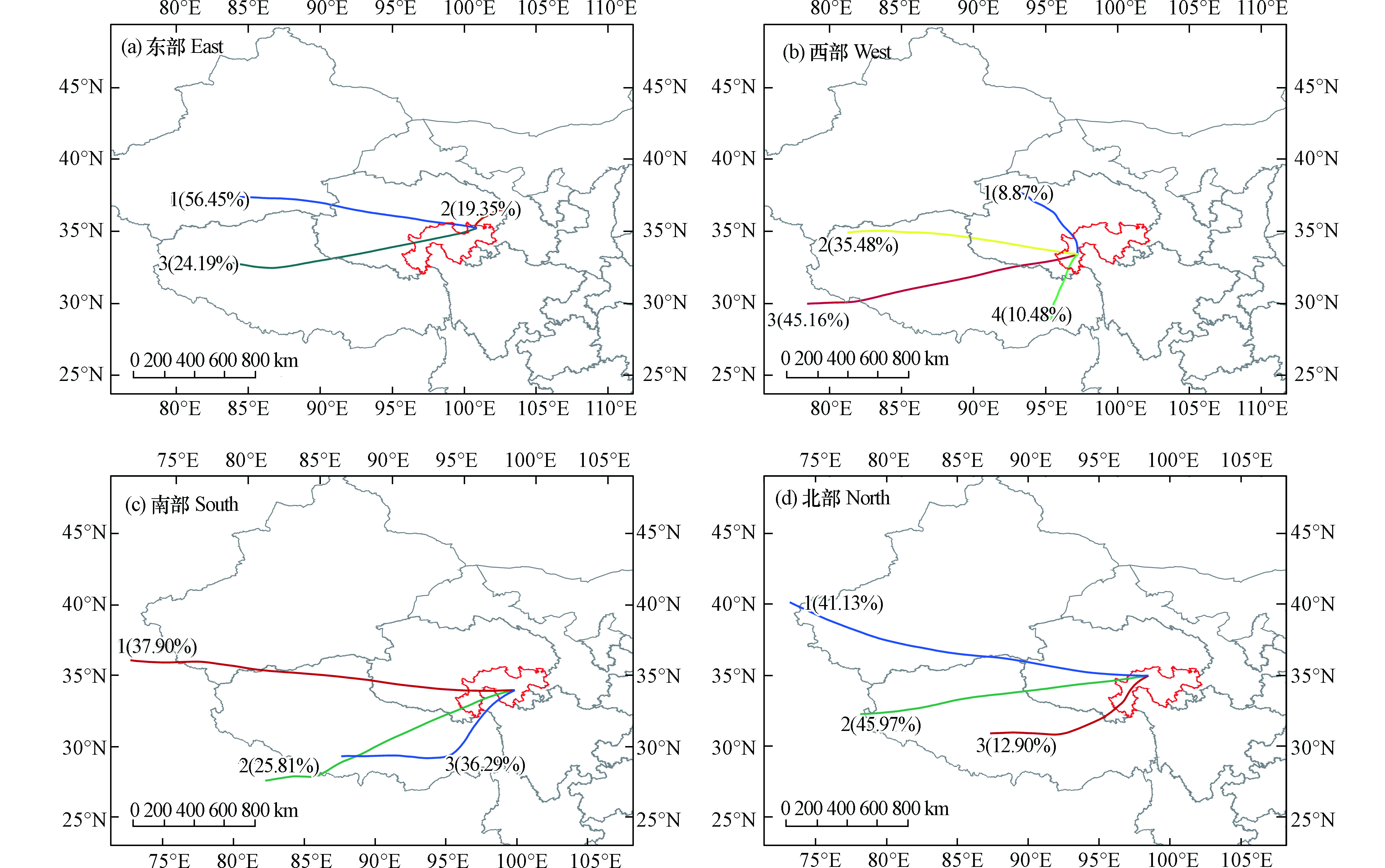-
痕量元素是指地球系统中以超低浓度水平存在的元素,痕量元素作为微量营养盐和生命必要元素,能维持各生态系统正常运行,而某些痕量元素通过富集作用,也可成为有毒元素,危害生态系统安全[1]。长期的污染排放不仅会造成局部的环境污染(大气、土壤和水),同时也会通过远距离的运输和扩散对远离城市的高海拔地区甚至极地的冰雪产生不利影响。降雪是湿沉降的一种重要类型,尤其是在高海拔和高纬度地区[2],积雪作为气候环境变化信息的载体,可以很好地记录大气元素的含量水平和历史变化[3],因此雪中的痕量元素(trace elements)是评估雪质的关键参数。
青藏高原面积达250万 km2,平均海拔超过4000 m,是全球海拔最高的一个独特的地理单元,被誉为“第三极”[4],同时青藏高原冰雪融水也为亚洲许多大江大河的发源地,如长江、黄河、雅鲁藏布江、恒河和印度河等,因此也被称为“亚洲水塔”[5]。青藏高原的环境极其脆弱,对全球变化和人类活动的响应高度敏感[6],针对青藏高原雪冰中痕量元素研究已成为研究的重点。早在1978年,章申等[7]对珠穆朗玛峰高海拔地区冰雪中痕量元素的研究发现,该区域痕量元素受到了人类活动的影响;李月芳[8-10]、Cong等[11]研究发现,青藏高原可可西里、古里雅冰芯、哈日钦冰川、煤矿冰川、冬克玛底冰川和喜马拉雅山等大气中的Cd和Pb等痕量元素受到了人为因素的影响;Kang等[12]通过青藏高原冰芯-湖芯重建过去500年气候变化,发现青藏高原Hg元素受到人类活动排放污染物的影响;Chen等[13]还发现,牦牛粪便的燃烧也会对青藏高原大气环境中痕量元素造成污染,这些结果都说明青藏高原大气环境已经受到人类活动的影响。
青藏高原是我国主要的积雪区之一,稳定积雪区面积占230万平方公里,对青藏高原积雪中痕量元素的研究主要集中在南部、北部、西部以及中部[8, 11-19],缺乏东部积雪痕量元素污染的数据,本研究位于青藏高原东部,青海省东南部,为稳定积雪区,通过对青藏高原东部积雪进行采样分析来研究痕量元素的时空分布特征以及来源分析,不仅为青藏高原东部积雪痕量元素研究提供了基础数据,还揭示了人类活动对痕量元素的贡献,对大气生态环境评估具有重要意义。
不同研究者在样品的前处理方法上有所不同,例如酸化强度的不同[6, 18],有研究者对样品进行消解处理,测定样品的消解浓度[2, 14-15, 20],甚至还有学者对未融化的积雪中痕量元素浓度直接测定[21]。基于不同的样品处理方法会导致同一样品中痕量元素的测定结果存在差异[22],因此不同地区样品中痕量元素研究结果就没有可比性[15]。
本研究选择在青藏高原东部地区采集样品并进行酸化处理,测定了样品中13种痕量元素(Li、Al、Cr、Mn、Fe、Co、Ni、Cu、Zn、Se、Cd、Ba、Pb)的酸化浓度,分析探究了上述元素的含量在青藏高原东部的时空变化特点和富集系数变化,以及利用后向轨迹模型探讨该区域痕量元素的潜在来源。
-
采样点位于青藏高原东部,地理位置位于97.99—100.89 °E、34.03—35.22 °N之间(图1),根据各区域内多年的积雪开始日期,结束日期以及持续时间和积雪厚度等将采样时间[23]分为5个时期:2018年积累期(2018年1月6日—1月9日),2018年稳定期(2018年2月20日—2月26日),2019年积累期(2018年12月3日—12月7日),2019年稳定期(2019年1月17日—1月20日),2019年消融期(2019年3月7日—3月10日),采集了98个采样点,共243个积雪样品(表1)。本研究将研究区分为4个区域:以玛多县为代表的北部区域,甘德县为代表的南部区域,河南蒙古族自治县为代表的东部区域,以称多县和玉树市为代表的西部区域。
采样前带上PVC清洁手套进行分层采样,采集积雪样品时候,使用干净的铲子挖取雪剖面,从上至下取表层的积雪样品,然后每5 cm分层采样,将雪压实后装至Whirl-Pak无菌自封袋,样品采集完成后放入保温箱,运送回西北大学并在−18℃的冷库内进行保存。
-
将积雪样品从冷库转移到超净实验室,将同一个采样点的积雪样品按照积雪采样深度等比例混合至预先酸洗过的低密度聚乙烯塑料(LDPE)瓶中,用纯化之后的硝酸对积雪样品进行酸化,加入硝酸至体积占比为2%,常温下酸化一个月至测定时取出,实验过程中均佩戴干净手套以及头套等防护措施保证样品的清洁。
积雪样品痕量元素浓度在西北大学陕西省地表系统与环境承载力重点实验室利用电感耦合等离子体质谱仪(Thermo Fisher iCAP RQ)进行测试分析。分析前,利用标准河水参考物质SLRS-5(National Research Council Canada, Ottawa, Canada)作为参考对该方法的准确度进行评价,测定结果均在误差允许范围内。将空白溶液里元素信号强度的标准偏差的3倍所对应的浓度值作为检测限,各元素测定检出限为:Li:0.56 pg·g−1、Al:272.85 pg·g−1、Cr:1.94 pg·g−1、Mn:0.62 pg·g−1、Fe:222.45 pg·g−1、Co:0.22 pg·g−1、Ni:1.05 pg·g−1、Cu:0.14 pg·g−1、Zn:5.57 pg·g−1、Se:5.64 pg·g−1、Cd:0.25 pg·g−1、Ba:0.32 pg·g−1、Pb:0.21 pg·g−1。
-
利用SPSS软件对研究区积雪样痕量元素浓度进行基础分析,计算均值、标准差等。空间分布采用反距离权重法( Inverse Distance Weight) 在AcrMap10.2中完成。
-
富集系数是用以表示大气颗粒物中元素的富集程度,判断和评价颗粒物中元素来源(自然来源和人为来源)的方法[24]。有研究指出[8],由质量分数占比较低的元素在酸化和消解两种处理方法背景下计算出来的EF值相比于其他质量分数占比高的元素所计算的值相差数倍,利用质量分数占比较高的元素计算出来的EF值更准确。在本研究中Fe元素占比最高,因此本研究将Fe被作为计算痕量元素的富集系数的参考元素,记为EFFe。
式中,X 为需要计算富集系数的元素,(X/Fe)sample为样品中X和Fe的平均浓度之比,(X /Fe)crust为地壳中相应元素X和Fe的浓度之比。不同大小的EFFe指示着不同的污染程度[25-26]。
本文应用Sutherland[27]提出的富集系数的标准。EF<2代表富集程度为最低,表明无污染或者最低程度的污染;2≤EF<5代表轻微程度的富集,表明存在轻微的污染;5≤EF<20代表显著的富集,表明存在明显的污染;20≤EF<40代表高度富集,表明存在严重的污染;EF≥40代表极端富集,表明存在极端的污染[8]。
-
HYSPLIT模型由美国国家海洋和大气管理局(NOAA)空气资源实验室和澳大利亚气象局(BOM)联合研发,是一种基于欧拉和拉格朗日混合型,用于计算和分析大气污染物输送、扩散轨迹的计算模型,该模型已经广泛应用于多种污染物在各个地区的传输和扩散研究[28]。本研究采用在HYSPLIT模型基础上改进扩展的TrajStat模块[29],结合4个区域在采样时间内上方500 m高度气流进行前72h后向轨迹模拟,每天计算4个时次(00:00、06:00、12:00、18:00),然后进行聚类分析得到4个区域主要气团的输送路径[11, 30]。
-
使用IDW(Inverse Distance Weighted)插值分析了各痕量元素的空间分布情况,IDW插值图(图2)显示了以甘德县为代表的南部区域中积雪痕量元素浓度较高(橙色和红色),明显高于其余几个地区;北部区域除了Li、Se、Pb元素浓度相对较高,其余元素浓度均处于较低水平(绿色和蓝色);研究区东部及西部中积雪痕量元素浓度相对较低(蓝色和深蓝色),呈此特征分布的痕量元素在采样点的浓度分别为:Li:0.80—31.64 μg·L−1、Al:314.22—19400.95 μg·L−1、 Cr:0.71—26.29 μg·L−1、Mn:15.59—1240.45 μg·L−1、Fe:489.56—24690.26 μg·L−1、Co:0.27—15.73 μg·L−1、Ni:0.75—38.94 μg·L−1、Cu:0.60—31.85 μg·L−1、Zn:3.64—154.20 μg·L−1、Se:0.001—0.65 μg·L−1、Cd:0.01—0.91 μg·L−1、Ba:5.17 —535.88 μg·L−1、Pb:1.07—59.72 μg·L−1。
研究区南部各元素的平均浓度均大于其余3个区域(表2),除元素Se以外各元素的平均浓度均在西部最低,Se元素平均浓度在东部区域最低,为0.1 μg·L−1;南部区域和西部区域元素浓度差异明显,南部区域各元素的平均浓度均为西部区域的1.80—3.41倍,说明研究区南部距离痕量元素的源区近而研究区西部距离痕量元素的源区较远。
13种痕量元素中,以粉尘源为主的Al、Fe和Ba的元素浓度在研究区内的变化幅度与除Se以外的其余元素浓度变化幅度(最大/最小浓度)相当,元素Se的变化幅度最大(最大/最小浓度为1204),元素Se与其余元素变化幅度差异明显,说明元素Se可能有着除粉尘源以外更为重要的人为源。
-
积雪融水的渗浸作用对积雪中化学离子的分布具有重要影响[31-32],但是针对痕量元素的研究相对较少。本研究针对青藏高原东部地区2018年积雪积累期和稳定期及2019年积雪积累期、稳定期和消融期进行对比研究,探究在不同时期各痕量元素的浓度时间变化特征。
积雪中痕量元素浓度总体呈现积累期高于稳定期,且2019年消融期远低于稳定期,其中Se元素的浓度在2019年消融期浓度呈未检出(图3)。相关研究表明积雪痕量元素的平均浓度与同期气温有着反相关关系[33],从积累期到稳定期过程中,随着温度的升高(表1),积雪中痕量元素的平均浓度小幅度降低;到达消融期时候,积雪开始消融,雪层中出现大量融水,融水携带大量痕量元素向下迁移导致痕量元素大幅度下降。
但本研究主要针对的是2018、2019年冬季3个时期积雪中痕量元素浓度的时间变化,将来可以通过长时间且连续的收集积雪样品观察积雪中痕量元素浓度的变化,分析各元素浓度时间变化特征。
-
青藏高原东部积雪中元素的富集系数计算结果表明(图4),在研究区内 Al, Cr, Co, Ba都没有受到或者只是受到最低程度的污染(EFFe<2),表明这4种元素主要来自于陆源粉尘,而其余元素都受到不同程度的污染(EFFe≥2),表明这些元素的沉积受到了人为源或除粉尘源以外其他自然源的影响。雪能从大气中收集痕量元素,大气中痕量元素来源又主要分为自然源和人为源,自然源主要包括土壤源、火山喷发、森林野火、海洋源以及岩石风化等[34-37],人为源主要包括化石燃料的燃烧、矿物开采和冶炼、垃圾焚烧、当地汽车尾气排放、冬季采暖等[11, 38-39]。
采样点位于青藏高原东部,距离海洋较远,所以海洋源对痕量元素造成的影响可以忽略不计;且采样时间内研究区干燥,气候恶劣,土壤源对其影响较小;再者采样时间内没有重大的火山喷发及森林野火;但是岩石风化有可能是痕量元素的来源之一,寇勇[40]对该地区离子研究表明Ca2+占总离子的55%,在采样时间内,研究区温差较大、蒸发量大且多阵性大风,成玉祥和莫彬彬等[41-42]在对岩石风化影响因素研究中发现温差以及水分迁移(蒸发)产生很大作用,随着温度变化以及水分蒸发,岩石风化到大气随积雪沉降,因此岩石风化有可能是痕量元素的潜在来源。
Cd和Se富集系数均大于5,表明这两种元素主要来自于人为源,大气污染物不仅来源于当地排放,也有可能来自于更远的源区随大气环流向研究区随降雪沉积到地面,造成研究区内元素不同程度的富集[15]。大气中Cd污染主要来自各种含镉工业、化石燃料的燃烧以及矿产资源的开发等[43, 44],Chen[13]等对青藏高原牦牛粪便的研究发现,牦牛粪便的燃烧对青藏高原大气造成Cd的污染,李月芳[9]、Kang[45]、刘亚军[15]等对古里雅冰芯、青藏高原大气气溶胶、青藏高原东南部的4条冰川中Cd的研究发现,污染物源于南亚石油和煤等能源的生产和消耗以及中亚地区大型工业的废气的排放;Se主要来自于化石燃料(煤)的燃烧,以及当地冬季的采暖措施均有可能造成Se排放到大气中然后随降雪沉积,张威[46]对该地区积雪中黑碳研究表明,该地区黑碳含量浓度较大,人类活动对这些地区的黑碳含量影响较高,黑碳主要来源于生物质和化石燃料的燃烧[47],寇勇[39]对该地离子研究发现积雪中SO42-与NO3−较高,积雪污染类型为煤烟型污染,这与当地化石燃料和冬季采暖(粪便的燃烧等)造成Se元素的高富集结果一致,但是仅根据EFFe的值很难区分本地排放和远距离传输。
-
在采样期间,研究区4个区域都受到了来自于西部的气流影响,这与青藏高原东部大部分区域在冬季盛行西风一致(图5)。
研究区北部和南部地区的气流主要来自南亚和西亚地区,尤其是南亚方向,且南亚地区因持续的人口增长以及工农业的快速发展,排放了大量的含Se、Cd等的污染物进入大气,李月芳[9]、黄菊[14]、刘亚军[15]、Kang[46]等研究均表明,南亚地区石油和煤等化石燃料的燃烧和工业废弃的排放对青藏高原地区大气造成了污染。Pacyna [48]等研究表明,亚洲Cd等重金属元素的排放量可占全球的50%,且南亚地区存在着大量的煤矿资源,煤矿资源的开采产生的Se、Cd等的排放均会随大气环流传输沉降对研究区造成影响。同时近期的研究表明,南亚地区排放的污染物可通过一些南北向的山谷或者直接由高空向青藏高原内陆传输[49];研究区东部地区主要受偏西气流的影响,上风方向是中亚和南疆地区, 中亚及南疆地区化石燃料(煤炭和石油)的燃烧,以及当地冬季的采暖措施等人类排放活动产生的Se、Cd等元素可经西风环流传输并随积雪沉降,黄菊[14]等对玉珠峰冰川等3条冰川研究表明,新疆化石燃料、工业、垃圾焚烧等人类活动产生的污染物沉降到3条冰川之上等;研究区西部地区气流主要来自南亚和西亚方向,南亚和西亚地区产生的污染物可能在西风环流的影响下传输抵达研究区西部。
-
(1)测定了2018年及2019年5个时期青藏高原东部积雪样品中痕量元素的酸化浓度, 呈现积累期>稳定期>消融期的特征;南部区域中积雪痕量元素浓度较高,明显高于其余几个地区;北部区域除了Li、Se、Pb元素浓度相对较高,其余元素浓度均处于较低水平;研究区东部及西部中积雪痕量元素浓度相对较低。
(2)在研究区内Al、Cr、Co和Ba元素主要来自于地壳粉尘(EFFe<2),其余元素都受到了人类活动的影响(EFFe≥2),其中Cd和Se元素有较高的EFFe值,可能主要来自于化石燃料(煤炭和石油)的燃烧、冬季的采暖措施、各种含Se和Cd工业废气的排放以及矿产资源的开发和远源的人类排放活动。
(3)结合后向气团轨迹分析发现研究区主要受到偏西和偏西南气流的影响,其上风方向的南亚、西亚及中亚可能为研究区污染物的主要源区。
青藏高原东部积雪中痕量元素的时空分布及污染评估
Spatial and temporal distribution and pollution evaluation of trace elements in snow in the Eastern Qinghai-Tibet Plateau
-
摘要: 青藏高原的环境极其脆弱,对全球变化和人类活动的响应高度敏感,为了解青藏高原东部地区积雪中痕量元素的时空变化以及污染程度,本研究对2018年积累期和稳定期及2019年积累期、稳定期和消融期5个时期积雪样品进行酸化处理,利用电感耦合等离子体质谱仪(ICP-MS)测定了样品中的13种痕量元素(Li、Al、Cr、Mn、Fe、Co、Ni、Cu、Zn、Se、Cd、Ba、Pb)的酸化浓度。研究结果表明,痕量元素的浓度在时间上呈现积累期>稳定期>消融期的特征;空间上呈现为南部区域痕量元素浓度明显高于其余区域;北部区域除了Li、Se、Pb浓度相对较高,其余元素浓度均处于较低水平;东部和西部区域积雪痕量元素浓度相对较低。计算富集系数(EF)得知Al、Cr、Co和Ba主要来自于地壳粉尘(EF<2),其余各元素都受到了人类活动的影响(EF≥2),其中Cd和Se具有着明显的污染(EF≥5),受人为排放活动影响较大,结合后向气团轨迹分析,研究区主要受到偏西和偏西南气流的影响,这表明污染物主要来自上风方向的南亚、西亚和中亚地区。Abstract: The Qinghai-Tibet Plateau has an extremely fragile environment, which is highly sensitive to global changes and human activities. In order to investigate the spatial distribution, temporal changes and the degree of pollution of trace elements in the snow from the eastern part of the Qinghai-Tibet Plateau, the acid leachable concentrations of 13 trace elements (Li, Al, Cr, Mn, Fe, Co, Ni, Cu, Zn, Se, Cd, Ba, Pb) in snow samples in the five periods during 2018 to 2019 has been determined by inductively coupled plasma mass spectrometry (ICP-MS). Comparing the concentrations of trace elements, the results indicate that temporally the concentrations of trace element present the characteristics of accumulation period> stable period> ablation period, and spatially the concentrations of trace elements in the southern region are significantly higher than that in the other regions, and except Li, Se, and Pb, the other elements’ concentrations are lower in the northern region, the eastern and concentration of trace elements in the eastern and western regions are relatively low. The enrichment factor (EF) shows that Al, Cr, Co and Ba mainly come from crustal dust (EF<2) and all other elements are affected by human activities (EF≥2). Among which, pollution of Cd and Se are more serious (EF≥5), which might be greatly affected by anthropogenic emissions. The cluster analyses of backward air trajectories indicates that he study area is mainly affected by the westerly and southwesterly airflow. The pollutants mainly come from South Asia, West Asia and Central Asia in the upwind direction.
-

-
表 1 研究区各采样点信息
Table 1. Information of sampling points in the study area
采样时间
Sampling time采样编号
Sample number坐标
Coordinate样品数目
Number of samples采样深度/cm
Sampling depth平均温度/°C
Average temperature2018年积累期
Accumulation period in 20181—7 97°59′17″—100°53′24″N;34°1′43″—35°13′27″E 15 5—17 −12 2018年稳定期
Stable period in 20188—32 97°8′52″—101°51′07″N;33°12′02″—35°8′26″E 55 5—48 −10.6 2019年积累期
Accumulation period in 201933—54 98°12′02″—100°52′54″N;33°54′14″—35°5′43″E 68 10—32 −12.1 2019年稳定期
Stable period in 201955—74 97°47′15″—100°5′32″N;33°57′57″—35°15′45″E 50 5—36 −10.5 2019年消融期
Ablation period in 201975—98 96°29′20″—98°39′05″N;32°11′58″—35°3′29″E 55 5—50 −7.9 表 2 研究区积雪痕量元素浓度(μg·L−1)
Table 2. The concentration of trace elements in snow in the study area(μg·L−1)
元素
Elements东部East 西部West 南部South 北部North 最大值
Max最小值
Min平均值
Mean最大值
Max最小值
Min平均值
Mean最大值
Max最小值
Min平均值
Mean最大值
Max最小值
Min平均值
MeanLi 13.93 4.40 7.41 16.17 0.80 5.78 31.64 1.73 10.80 30.56 0.88 9.71 Al 6571.67 2156.97 3666.94 6215.65 314.25 2205.73 19400.95 857.93 5158.95 10907.88 341.37 3399.63 Cr 11.13 3.48 6.30 11.03 0.78 4.31 26.29 1.62 8.29 20.34 0.71 6.61 Mn 265.50 83.14 149.38 337.52 18.44 112.65 1240.45 36.20 288.94 676.83 15.59 189.89 Fe 6983.87 2171.03 3952.34 7888.96 489.56 2723.78 24690.26 1242.55 6444.92 15352.55 530.86 4597.96 Co 4.96 1.50 2.74 5.06 0.29 1.84 15.73 0.71 4.23 10.24 0.27 3.04 Ni 13.39 4.03 7.30 13.66 0.84 5.11 38.94 1.86 11.12 26.61 0.75 8.34 Cu 9.89 3.05 5.48 9.49 0.66 3.66 31.85 1.78 8.73 21.24 0.60 6.43 Zn 35.11 12.17 23.32 42.34 3.64 15.62 154.20 9.98 44.16 72.75 4.91 24.49 Se 0.22 0.02 0.10 0.47 0.001 0.12 0.65 0.01 0.18 0.56 0.001 0.17 Cd 0.15 0.08 0.11 0.14 0.01 0.05 0.91 0.03 0.17 0.30 0.01 0.09 Ba 74.60 29.90 51.33 101.59 5.17 36.63 535.88 16.16 111.28 238.95 6.46 65.06 Pb 12.79 3.72 7.25 14.31 1.24 5.92 36.31 2.77 10.69 59.72 1.07 9.63 -
[1] HUA R, HOU S G, LI Y S, et al. Arsenic record from a 3 m snow pit at Dome Argus, Antarctica [J]. Antarctic Science, 2016, 28(4): 305-312. doi: 10.1017/S0954102016000092 [2] XUE H H, CHEN W L, LI M, et al. Assessment of major ions and trace elements in snow: A case study across northeastern China, 2017-2018 [J]. Chemosphere, 2020, 251: 126328. doi: 10.1016/j.chemosphere.2020.126328 [3] MCCONNELL J R, EDWARDS R. Coal burning leaves toxic heavy metal legacy in the Arctic [J]. PNAS, 2008, 105(34): 12140-12144. doi: 10.1073/pnas.0803564105 [4] YAO T D, THOMPSON L G, MOSBRUGGER V, et al. Third pole environment (TPE) [J]. Environmental Development, 2012, 3: 52-64. doi: 10.1016/j.envdev.2012.04.002 [5] IMMERZEEL W W, van BEEK L P H, BIERKENS M F P. Climate change will affect the Asian water towers [J]. Science, 2010, 328(5984): 1382-1385. doi: 10.1126/science.1183188 [6] 姚檀栋. 敏感脆弱、影响深远的青藏高原环境 [J]. 大自然, 2010(2): 1. YAO T D. The sensitive, fragile and far-reaching Qinghai-Tibet Plateau environment [J]. China Nature, 2010(2): 1(in Chinese).
[7] 章申. 珠穆朗玛峰高海拔地区冰雪中的微量元素 [J]. 地理学报, 1979, 34(1): 12-17. doi: 10.3321/j.issn:0375-5444.1979.01.002 ZHANG S. Content of trace elements in glacial ice and snow in the mt. Qomolangma region [J]. Acta Geographica Sinica, 1979, 34(1): 12-17(in Chinese). doi: 10.3321/j.issn:0375-5444.1979.01.002
[8] LI Y F, HUANG J, LI Z, et al. Atmospheric pollution revealed by trace elements in recent snow from the central to the northern Tibetan Plateau [J]. Environmental Pollution, 2020, 263: 114459. doi: 10.1016/j.envpol.2020.114459 [9] 李月芳, 姚檀栋, 王宁练, 等. 青藏高原古里雅冰芯中痕量元素镉记录的大气污染: 1900—1991 [J]. 环境化学, 2000, 19(2): 176-180. doi: 10.3321/j.issn:0254-6108.2000.02.015 LI Y F, YAO T D, WANG N L, et al. Atmosphere pollution revealed by cadmium in the guliya ice core, qinghaitibet plateau: 1990-1991 [J]. Environmental Chemistry, 2000, 19(2): 176-180(in Chinese). doi: 10.3321/j.issn:0254-6108.2000.02.015
[10] 李月芳, 姚檀栋, 王宁连, 等. 可可西里马兰冰川冰芯中Cd和Pb的浓度 [J]. 环境化学, 2002, 21(2): 194-196. doi: 10.3321/j.issn:0254-6108.2002.02.017 LI Y F, YAO T D, WANG N L, et al. The concentrations of Cd and Pb in ice core from Malan glacier, Qinghai [J]. Environmental Chemistry, 2002, 21(2): 194-196(in Chinese). doi: 10.3321/j.issn:0254-6108.2002.02.017
[11] CONG Z Y, KANG S C, ZHANG Y L, et al. New insights into trace element wet deposition in the Himalayas: Amounts, seasonal patterns, and implications [J]. Environmental Science and Pollution Research, 2015, 22(4): 2735-2744. doi: 10.1007/s11356-014-3496-1 [12] KANG S C, HUANG J, WANG F Y, et al. Atmospheric mercury depositional chronology reconstructed from lake sediments and ice core in the Himalayas and Tibetan Plateau [J]. Environmental Science & Technology, 2016, 50(6): 2859-2869. [13] LI Y F, LI Z, COZZI G, et al. Signals of pollution revealed by trace elements in recent snow from mountain glaciers at the Qinghai–Tibetan Plateau [J]. Chemosphere, 2018, 200: 523-531. doi: 10.1016/j.chemosphere.2018.01.039 [14] CHEN P F, KANG S C, BAI J K, et al. Yak dung combustion aerosols in the Tibetan Plateau: Chemical characteristics and influence on the local atmospheric environment [J]. Atmospheric Research, 2015, 156: 58-66. doi: 10.1016/j.atmosres.2015.01.001 [15] 黄菊, 李月芳, 李真. 青藏高原五条冰川表雪中痕量元素的空间分布及污染评估 [J]. 环境化学, 2017, 36(7): 1506-1515. doi: 10.7524/j.issn.0254-6108.2017.07.2016110808 HUANG J, LI Y F, LI Z. Spatial distribution and pollution assessment of trace elements in the surface snow of five glaciers on the Tibetan Plateau [J]. Environmental Chemistry, 2017, 36(7): 1506-1515(in Chinese). doi: 10.7524/j.issn.0254-6108.2017.07.2016110808
[16] 刘亚军, 张玉兰, 康世昌, 等. 青藏高原东南部冰川雪冰重金属元素特征 [J]. 冰川冻土, 2017, 39(6): 1200-1211. LIU Y J, ZHANG Y L, KANG S C, et al. Characteristics of heavy metal elements deposited on glaciers in the southeastern Tibetan Plateau [J]. Journal of Glaciology and Geocryology, 2017, 39(6): 1200-1211(in Chinese).
[17] DONG Z W, KANG S C, QIN X, et al. New insights into trace elements deposition in the snow packs at remote alpine glaciers in the northern Tibetan Plateau, China [J]. Science of the Total Environment, 2015, 529: 101-113. doi: 10.1016/j.scitotenv.2015.05.065 [18] BEAUDON E, GABRIELLI P, SIERRA-HERNÁNDEZ M R, et al. Central Tibetan Plateau atmospheric trace metals contamination: A 500-year record from the Puruogangri ice core [J]. Science of the Total Environment, 2017, 601/602: 1349-1363. doi: 10.1016/j.scitotenv.2017.05.195 [19] BURN-NUNES L, VALLELONGA P, LEE K, et al. Seasonal variations in the sources of natural and anthropogenic lead deposited at the East Rongbuk Glacier in the high-altitude Himalayas [J]. Science of the Total Environment, 2014, 487: 407-419. doi: 10.1016/j.scitotenv.2014.03.120 [20] HUANG J, LI Y F, LI Z, et al. Spatial variations and sources of trace elements in recent snow from glaciers at the Tibetan Plateau [J]. Environmental Science and Pollution Research, 2018, 25(8): 7875-7883. doi: 10.1007/s11356-017-0904-3 [21] ALFONSO J A, CORDERO R R, ROWE P M, et al. Elemental and mineralogical composition of the western Andean snow (18°S–41°S) [J]. Scientific Reports, 2019, 9: 8130. doi: 10.1038/s41598-019-44516-5 [22] 熊隆飞, 李月芳, 李真. 基于两种样品前处理方法对比研究小冬克玛底冰川雪坑中痕量元素 [J]. 环境化学, 2015, 34(3): 520-528. doi: 10.7524/j.issn.0254-6108.2015.03.2014070803 XIONG L F, LI Y F, LI Z. Comparative study of trace elements in snow pit from Xiaodongkemadi glacier in Tanggula mountain based on two sample preparation method [J]. Environmental Chemistry, 2015, 34(3): 520-528(in Chinese). doi: 10.7524/j.issn.0254-6108.2015.03.2014070803
[23] 李晓峰, 梁爽, 赵凯, 等. 基于气象要素的中国积雪类型划分及积雪特征分布 [J]. 冰川冻土, 2020, 42(1): 62-71. LI X F, LIANG S, ZHAO K, et al. Snow cover classification based on climate variables and its distribution characteristics in China [J]. Journal of Glaciology and Geocryology, 2020, 42(1): 62-71(in Chinese).
[24] REIMANN C, de CARITAT P. Distinguishing between natural and anthropogenic sources for elements in the environment: Regional geochemical surveys versus enrichment factors [J]. Science of the Total Environment, 2005, 337(1/2/3): 91-107. [25] ZHANG H, WANG Z F, ZHANG Y L, et al. The effects of the Qinghai-Tibet railway on heavy metals enrichment in soils [J]. Science of the Total Environment, 2012, 439: 240-248. doi: 10.1016/j.scitotenv.2012.09.027 [26] YI Y J, SUN J, TANG C H, et al. Ecological risk assessment of heavy metals in sediment in the upper reach of the Yangtze River [J]. Environmental Science and Pollution Research, 2016, 23(11): 11002-11013. doi: 10.1007/s11356-016-6296-y [27] SUTHERLAND R A. Bed sediment-associated trace metals in an urban stream, Oahu, Hawaii [J]. Environmental Geology, 2000, 39(6): 611-627. doi: 10.1007/s002540050473 [28] DRAXIER R, HESS G. An overview of the HYSPLIT_4 modeling system of trajectories, dispersion, and deposition [J]. Australian Meteorological Magazine, 1998, 47(4): 295-308. [29] WANG Y Q. MeteoInfo: GIS software for meteorological data visualization and analysis [J]. Meteorological Applications, 2014, 21(2): 360-368. doi: 10.1002/met.1345 [30] NIU Z Y, SUN P J, LI X L, et al. Spatial characteristics and geographical determinants of mercury and arsenic in snow in northeastern China [J]. Atmospheric Pollution Research, 2020, 11(11): 2068-2075. doi: 10.1016/j.apr.2020.08.025 [31] EICHLER A, SCHWIKOWSKI M, GÄGGELER H W. Meltwater-induced relocation of chemical species in Alpine firn [J]. Tellus B:Chemical and Physical Meteorology, 2001, 53(2): 192-203. doi: 10.3402/tellusb.v53i2.16575 [32] LI Z Q, EDWARDS R, MOSLEY-THOMPSON E, et al. Seasonal variability of ionic concentrations in surface snow and elution processes in snow–firn packs at the PGPI site on Ürümqi glacier No. 1, eastern Tien Shan, China [J]. Annals of Glaciology, 2006, 43: 250-256. doi: 10.3189/172756406781812069 [33] 李传金, 李忠勤, 李月芳, 等. 天山乌鲁木齐河源1号冰川积雪内痕量金属元素的季节变化及其环境意义 [J]. 中国科学(D辑:地球科学), 2007, 37(5): 676-681. LI C J, LI Z Q, LI Y F, et al. Seasonal changes of trace metal elements in the snow of Glacier No. 1 at the headwaters of the Urumqi River in Tianshan Mountains and their environmental significance [J]. Science in China (Series D:Earth Sciences), 2007, 37(5): 676-681(in Chinese).
[34] LIU B, KANG S C, SUN J M, et al. Wet precipitation chemistry at a high-altitude site (3, 326 m a. s. l. ) in the southeastern Tibetan Plateau [J]. Environmental Science and Pollution Research, 2013, 20(7): 5013-5027. doi: 10.1007/s11356-012-1379-x [35] SHIMAMURA T, IWASHITA M, IIJIMA S, et al. Major to ultra trace elements in rainfall collected in suburban Tokyo [J]. Atmospheric Environment, 2007, 41(33): 6999-7010. doi: 10.1016/j.atmosenv.2007.05.010 [36] SONG F, GAO Y. Chemical characteristics of precipitation at metropolitan Newark in the US East Coast [J]. Atmospheric Environment, 2009, 43(32): 4903-4913. doi: 10.1016/j.atmosenv.2009.07.024 [37] 李月梅, 潘月鹏, 王跃思, 等. 华北工业城市降水中金属元素污染特征及来源 [J]. 环境科学, 2012, 33(11): 3712-3717. LI Y M, PAN Y P, WANG Y S, et al. Chemical characteristics and sources of trace metals in precipitation collected from a typical industrial city in Northern China [J]. Environmental Science, 2012, 33(11): 3712-3717(in Chinese).
[38] 黄大伟, 桂和荣. 宿南矿区土壤重金属含量特征及其来源解析 [J]. 地球与环境, 2017, 45(5): 546-554. HUANG D W, GUI H R. Sources analysis and content characteristics of soil heavy metal in Sunan mining area, China [J]. Earth and Environment, 2017, 45(5): 546-554(in Chinese).
[39] 江用彬, 汪晓云, 黄燕军, 等. 黄山景观区域降雨微量元素化学组成及来源 [J]. 环境监测管理与技术, 2018, 30(5): 64-67. doi: 10.3969/j.issn.1006-2009.2018.05.015 JIANG Y B, WANG X Y, HUANG Y J, et al. Chemical composition and source of trace elements in rainwater in Huangshan scenic spot [J]. The Administration and Technique of Environmental Monitoring, 2018, 30(5): 64-67(in Chinese). doi: 10.3969/j.issn.1006-2009.2018.05.015
[40] 寇勇. 中国北方典型积雪区积雪中水溶性离子分布特征及来源研究[D]. 西安: 西北大学, 2020. KOU Y. Spatial distribution and sources of water soluble ions in snow of typical snow area across Northern China[D]. Xi'an: Northwest University, 2020(in Chinese).
[41] 成玉祥, 段玉贵, 李格烨, 等. 岩石冻融风化作用积累泥石流物源试验研究 [J]. 灾害学, 2015, 30(2): 46-50. doi: 10.3969/j.issn.1000-811X.2015.02.009 CHENG Y X, DUAN Y G, LI G Y, et al. The study on debris flows material source accumulation by rock freezing and thawing weathering test [J]. Journal of Catastrophology, 2015, 30(2): 46-50(in Chinese). doi: 10.3969/j.issn.1000-811X.2015.02.009
[42] 莫彬彬, 连宾. 长石风化作用及影响因素分析 [J]. 地学前缘, 2010, 17(3): 281-289. MO B B, LIAN B. Study on feldspar weathering and analysis of relevant impact factors [J]. Earth Science Frontiers, 2010, 17(3): 281-289(in Chinese).
[43] 吴红璇, 史常青, 张艳, 等. 乌海市煤矿区及周边春季降尘污染特征及来源分析 [J]. 环境科学, 2020, 41(3): 1167-1175. WU H X, SHI C Q, ZHANG Y, et al. Characteristics and source apportionment of dustfall pollution in the coal mine area and surrounding areas of Wuhai City in Spring [J]. Environmental Science, 2020, 41(3): 1167-1175(in Chinese).
[44] 高雯媛, 邹霖, 邢宏霖, 等. 邵阳市城区大气降尘中的Pb、Cd的污染及环境风险评价 [J]. 环境污染与防治, 2015, 37(6): 34-40. GAO W Y, ZOU L, XING H L, et al. Study on the pollution and environmental risk assessment of Pb, Cd in atmospheric deposition in urban area of Shaoyang [J]. Environmental Pollution & Control, 2015, 37(6): 34-40(in Chinese).
[45] KANG S C, CHEN P F, LI C L, et al. Atmospheric aerosol elements over the inland Tibetan Plateau: Concentration, seasonality, and transport [J]. Aerosol and Air Quality Research, 2016, 16(3): 789-800. doi: 10.4209/aaqr.2015.05.0307 [46] 张威. 中国北方典型积雪区积雪中黑碳含量的空间分布及其来源分析[D]. 西安: 西北大学, 2020. ZHANG W. Spatial distribution and sources analysis of black carbon contents in snow of typical snow area across Northern China[D]. Xi'an: Northwest University, 2020(in Chinese).
[47] 高少鹏. 青藏高原雪冰中的燃烧排放指示物及其环境意义[D]. 北京: 中国地质大学(北京), 2016. GAO S P. The tracers of combustion emission in snow of Tibetan Plateau and their environmental implications[D]. Beijing: China University of Geosciences, 2016(in Chinese). University of Geosciences Doctoral Dissertation, 2016. ( in Chinese) .
[48] PACYNA J M, PACYNA E G. An assessment of global and regional emissions of trace metals to the atmosphere from anthropogenic sources worldwide [J]. Environmental Reviews, 2001, 9(4): 269-298. doi: 10.1139/a01-012 [49] CONG Z Y, KAWAMURA K, KANG S C, et al. Penetration of biomass-burning emissions from South Asia through the Himalayas: New insights from atmospheric organic acids [J]. Scientific Reports, 2015, 5: 9580. doi: 10.1038/srep09580 -




 下载:
下载:





